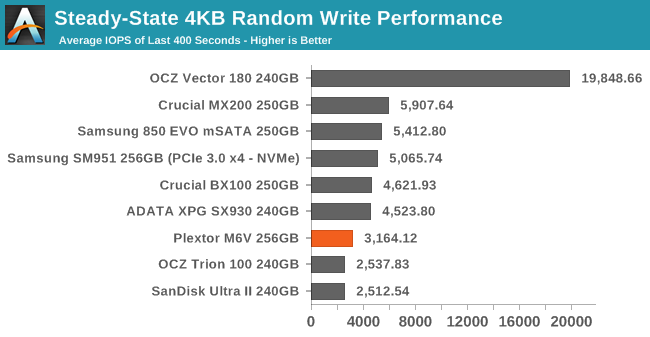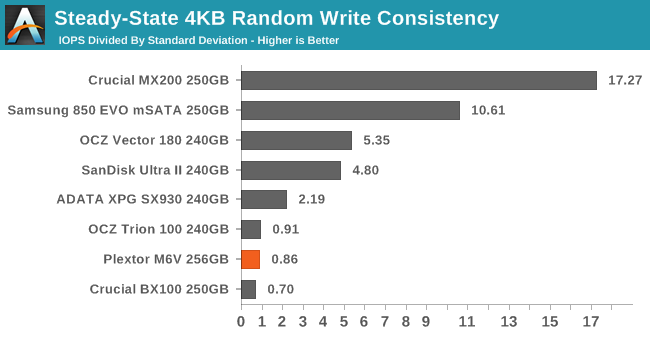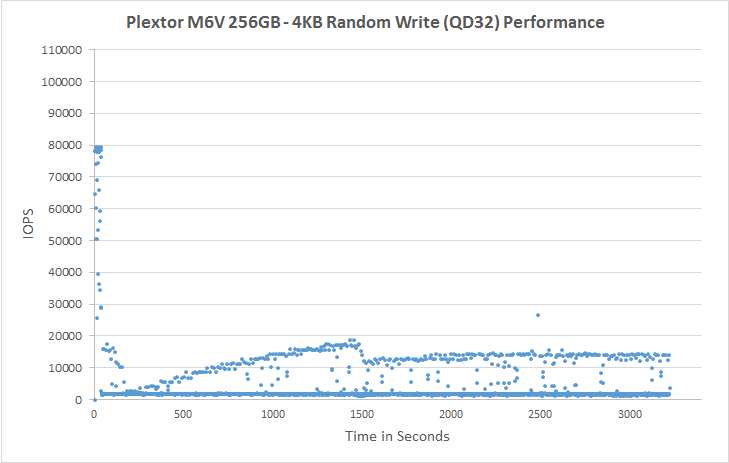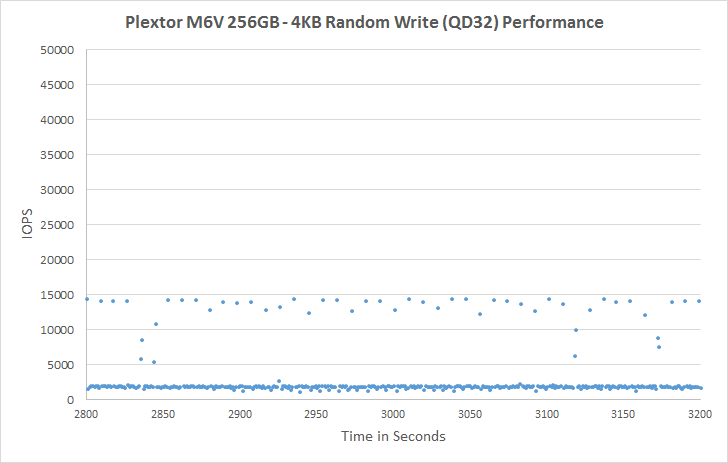The Plextor M6V (256GB) SSD Review
by Billy Tallis on October 12, 2015 8:00 AM ESTPerformance Consistency
Our performance consistency test saturates the drive with 4kB random writes for a full hour, with a queue depth of 32, the maximum supported by the AHCI protocol used by SATA and most PCIe drives. This puts the drive's controller under maximum stress and writes enough data to exhaust all free space and spare area on the drive. This is an unrealistic workload for any client use, but it provides a worst-case scenario for long-term heavy use, and it sheds light on how different SSD controllers behave and if their performance will hold up as they fill up.
The average of the last 400 seconds of the test gives us a steady-state IOPS rating that is usually very different from what the manufacturer specifies for a new, empty drive. We also quantify the consistency of the drive's random write performance, and provide plots of the performance over the course of the test.

The M6V's steady-state performance falls well behind the Crucial BX100 and only slightly ahead of drives using TLC NAND, pointing to either significant firmware differences or lower performance from the Toshiba 15nm MLC than Micron's 16nm MLC.

Plextor is able to eke out a little more consistency from the SM2246EN, but unfortunately this is due to the best-case being worse, rather than a significant improvement in the worst-case IOPS.
 |
|||||||||
| Default | |||||||||
Looking at the whole duration of the test, we see that once the M6V is filled and performance takes a nosedive, the M6V has a very slow recovery toward its steady state of occasionally reaching around 15k IOPS. Like the BX100, it has a pretty solid baseline and there are no garbage-collection pauses that drop it in to hard drive territory.
 |
|||||||||
| Default | |||||||||










51 Comments
View All Comments
eddieobscurant - Monday, October 12, 2015 - link
when is the samsung 950 pro review coming up?Billy Tallis - Monday, October 12, 2015 - link
Soon.I wanted to start with a more straightforward and predictable review to make sure I had the test rig set up correctly. The 950 Pro review calls for some deeper investigation than this one, since it's the first real mainstream consumer NVMe drive and there are custom drivers and stuff like that to investigate.
coolhardware - Tuesday, October 13, 2015 - link
Sweet action, looking forward to it! :-)Coup27 - Tuesday, October 13, 2015 - link
Billy when you do the review for the 950 Pro would you be able to do a couple of paragraphs recapping over SATA Express, PCI Express, M.2, U.2 and anything else related to it? I've half kept up to date but I don't think they've done a great job of keeping it clear either.Xichekolas - Wednesday, October 14, 2015 - link
Mind having a section on Linux support/compatibility/etc in the 950 review? When you say "custom drivers and stuff like that to investigate" it makes me dread the buy-new-product-wait-a-month-for-kernel-support routine.Billy Tallis - Wednesday, October 14, 2015 - link
As I understand it, the custom drivers for NVMe is a thing everybody is doing to get around the limitations of Microsoft's driver, like not being able to send administrative commands to the drive (including the equivalent of secure erase). At least some of the features of Samsung's SSD Magician software will probably require their NVMe driver. I have yet to encounter a custom NVMe driver for Linux, only vendor-specific management tools.Anyways, the 950 Pro review's section on compatibility will be as thorough as I have time and resources for. I've done some work to equip our testbed to measure PCIe power consumption for the first time, which means I really should re-test the SM951 and XP941 for comparison's sake.
Cliff34 - Monday, October 12, 2015 - link
Thanks for the review. But it seems like these days if the SSDs cannot differentiate themselves either in price (cheaper the better), speed (faster the better) and reliability (the longer the better), there's very little incentive to buy a SSD that's somewhere in the middle.If you want value, get the BX100 (or one that's on sale) or if you want speed, get the Samsung 850 Pro or the Sandisk Extreme Pro.
zodiacfml - Monday, October 12, 2015 - link
Even Intel/Micron isn't sure if they can compete with Samsung.MagickChicken - Wednesday, October 14, 2015 - link
So am I right in thinking that this generation of consumer-grade SATA SSDs operates roughly 50% better than my current SSD, the Vertex 3?http://www.anandtech.com/show/4256/the-ocz-vertex-...
Seems like there'd be a higher increase in performance over four years considering how new the market was in 2011, though I'm certainly not going to knock the 50-60% drop in $/GB. Or is there a more significant change in the benchmarks that I'm not picking up on?
Billy Tallis - Sunday, October 18, 2015 - link
Some of the benchmark metrics are simply hitting SATA limits on bandwidth and latency. Others are constrained by the limited parallelism of interactive I/O, so the fundamental performance limits of NAND flash are showing through.Also keep in mind that pretty much all NAND production advances have been used to drive down cost, not to improve performance or reliability. We could be making SLC that's cheaper than the MLC used in early SATA SSDs, but the market prefers increased capacity and that's why we have TLC drives now and complicated slow error correction methods to keep them mostly working.